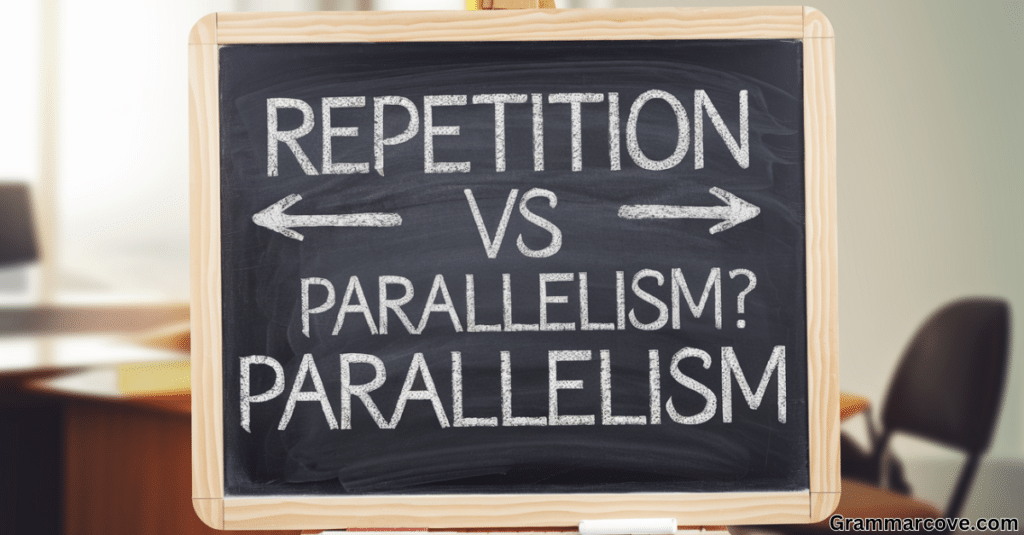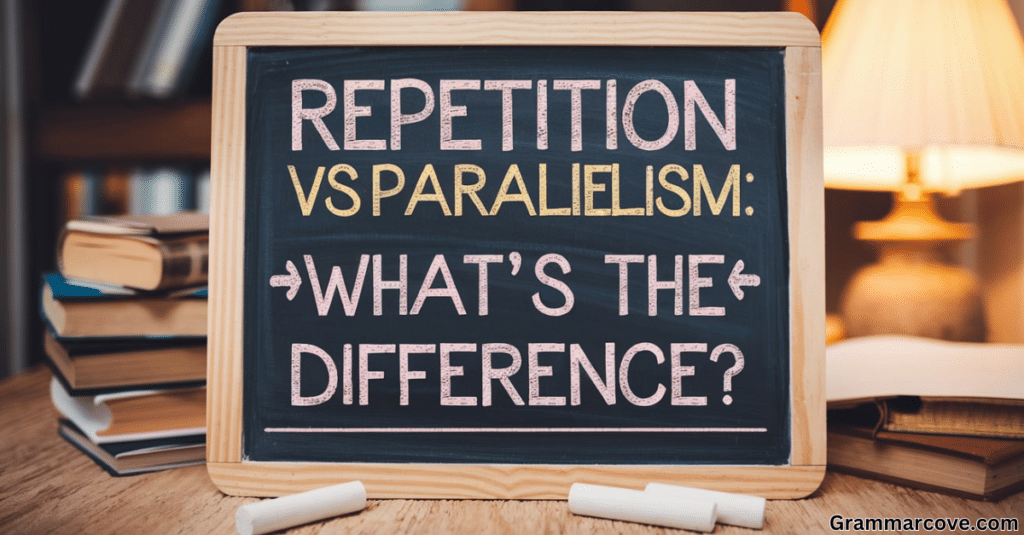Understanding the difference between repetition-vs-parallelism is essential for anyone looking to improve their writing skills. These two rhetorical devices, while related in some ways, serve distinct purposes in both written and spoken language. By grasping the unique roles of repetition-vs-parallelism, you can enhance the effectiveness of your communication. Whether you’re writing an email, composing a poem, or crafting a persuasive essay, these devices can help you create more engaging and memorable content.
In this article, we’ll explore repetition vs parallelism, define each concept, highlight their differences, and provide practical examples to illustrate how they function in writing.
Repetition Definition and Origins
Repetition is a literary device in which words, phrases, or sounds are repeated to create emphasis, rhythm, or a sense of unity within a piece of writing. The purpose of repetition in writing is often to reinforce a point, make an idea more memorable, or evoke an emotional response from the reader or listener. The origins of repetition lie in ancient rhetoric, where repetition was used to drive home arguments, much like it is used today.
Types of Repetition
There are several types of repetition that writers use to emphasize ideas or create rhythm. Some common types include:
- Anaphora: Repetition of a word or phrase at the beginning of successive clauses.
- Example: “I have a dream that one day… I have a dream that one day…”
- Epiphora: Repetition of a word or phrase at the end of successive clauses.
- Example: “He loves to read. She loves to write. They love to explore.”
- Symploce: A combination of anaphora and epiphora, where both the beginning and ending phrases are repeated.
- Example: “I want peace; you want peace; we all want peace.”
These forms of repetition can add emphasis, make arguments more compelling, or create a rhythmic flow that enhances the reader’s experience.
Parallelism Definition and Origins
Parallelism, also known as parallel structure, refers to the use of consistent grammatical structures within a sentence or across sentences to create balance and clarity. This device helps writers present ideas in a way that is easy to follow and aesthetically pleasing.
The origins of parallelism are rooted in ancient rhetoric as well, where it was used to clarify ideas and create persuasive arguments. In modern writing, parallelism in writing helps establish coherence and unity in a text.
Parallel Structure vs Repetition
While both parallelism and repetition involve some form of recurring elements, the key difference between repetition and parallelism lies in their structure and purpose.
- Repetition focuses on repeating specific words, phrases, or sounds to emphasize a point or create a rhythm.
- Parallelism, on the other hand, is concerned with the grammatical balance of elements, ensuring that similar ideas are presented in a consistent, structured way.
Importance of Parallelism
Parallelism enhances the flow and clarity of a text. Whether you’re writing a speech, an academic paper, or an email, employing parallel structures makes your writing more readable and engaging. This device also helps to underscore key points, making them easier for the reader or listener to absorb.
Repetition vs Parallelism: Key Differences

The difference between repetition and parallelism can be summarized in a few key points:
- Repetition emphasizes a specific word or phrase to reinforce an idea or create emphasis.
- Parallelism ensures consistency in structure, making a sentence or series of sentences easier to understand.
- Repetition in writing can be more emotional, drawing attention to key ideas or feelings.
- Parallelism in writing is more about clarity and coherence, making sure ideas are presented in an equal and balanced way.
Examples of Repetition
Let’s look at a few examples of repetition in different contexts:
Example 1: Repetition in an Email
Imagine you’re writing an email to a colleague, Sarah Banks, reminding her of an upcoming deadline. You might use repetition for emphasis, especially if you want to highlight the urgency:
Subject: Urgent: Deadline for Project XYZ
Dear Sarah,
I just wanted to remind you that the deadline for Project XYZ is quickly approaching. We need to complete the project by Friday—Friday is the absolute latest. Please ensure that all tasks are submitted by Friday so we can stay on track.
Thank you for your attention to this!
Best regards,
John
In this example, the repetition of the word “Friday” stresses the importance of the deadline and helps ensure the message stands out.
Example 2: Repetition in Poetry
Repetition in poetry often serves to create rhythm or emphasize a particular theme. Take this classic example from Edgar Allan Poe’s The Raven:
“Nevermore.”
Here, Poe uses repetition of the word “nevermore” to create an eerie, rhythmic effect while reinforcing the poem’s themes of despair and finality.
Examples of Parallelism
Parallelism, as noted earlier, ensures balance in the structure of sentences. Let’s look at a few parallelism examples:
Example 1: Parallelism in an Email
Let’s say you’re sending an email to your boss, Mr. Thompson, about your progress on a report. A well-structured email with parallelism might look like this:
Subject: Progress on Quarterly Report
Dear Mr. Thompson,
I’ve made great strides with the report. I’ve analyzed the data, I’ve outlined the sections, and I’ve reviewed the initial draft. The final version will be ready for your review by Friday.
Best regards,
Sarah
In this case, the repeated structure of “I’ve [verb]” makes the email clearer and easier to read. It also emphasizes the action-oriented progress you’ve made.
Example 2: Parallelism in Poetry
Parallelism can also be seen in poetry. Consider this excerpt from Song of Myself by Walt Whitman:
“I celebrate myself, and sing myself.
And what I assume you shall assume,
For every atom belonging to me as good belongs to you.”
The parallel structure here enhances the flow of the lines and reinforces the theme of self-celebration and unity.
Repetition in Writing: Why It Works
The use of repetition in sentences can be a powerful tool, but it must be used sparingly to avoid sounding redundant. Effective repetition involves using a word or phrase at strategic points to create emphasis or to make an idea more memorable.
- Emotional impact: Repeating key words or phrases can evoke strong emotions in your audience. Think of Martin Luther King Jr.’s famous “I Have a Dream” speech, where the phrase “I have a dream” is repeated to inspire hope and unity.
- Rhythm: Repetition also serves to create a rhythm that draws the reader’s attention and makes the writing more engaging.
Parallelism in Writing: How to Use It
When crafting sentences, using parallelism ensures that each element within a list or series is presented in the same grammatical structure. This is especially useful in persuasive writing, speeches, and academic papers.
- List of actions: Ensure that each verb form in a series is consistent. For example:
- Correct: “She likes running, biking, and swimming.”
- Incorrect: “She likes running, biking, and to swim.”
- Nouns: If you list nouns, keep the structure consistent.
- Correct: “The project requires dedication, focus, and perseverance.”
- Incorrect: “The project requires dedication, focusing, and to persevere.”
Common Mistakes in Repetition and Parallelism
Even experienced writers can fall into the trap of misusing repetition or parallelism. Here are a few common mistakes:
- Overusing repetition: While repetition can be a powerful tool, overusing it can make your writing sound tedious. Be strategic with your repetition.
- Inconsistent parallelism: When you start a list or series with a certain grammatical structure, stick to it throughout the sentence or paragraph. Inconsistent structures can confuse your reader.
Tips for Using Repetition Effectively
Here are some quick tips for using repetition in your writing:
- Use repetition for emphasis: If you want to highlight an important idea or theme, repeat key phrases to make them stand out.
- Avoid redundancy: Don’t repeat the same word or phrase too often. Instead, vary your language while maintaining the emphasis.
- Be mindful of rhythm: Repetition can help establish a rhythm in your writing, so use it to enhance the flow of your work.
How to Use Parallelism
To use parallelism effectively in your writing:
- Ensure consistency: Whether you’re listing actions, qualities, or ideas, maintain the same grammatical structure throughout.
- Use it to clarify ideas: Parallelism can help break down complex ideas into easy-to-understand, balanced components.
- Use it for emphasis: Just like repetition, parallelism can also emphasize a key point when used appropriately.
Conclusion
In summary, both repetition-vs-parallelism are essential tools in the writer’s toolbox. While repetition works by drawing attention to specific words or ideas through repeated use, parallelism helps create balance and clarity by maintaining a consistent structure. By understanding the difference between repetition and parallelism, and knowing when to use each technique, you can craft more engaging, effective, and memorable content.


